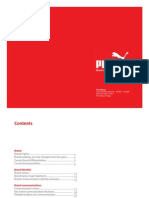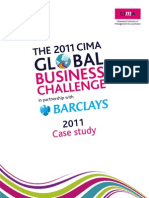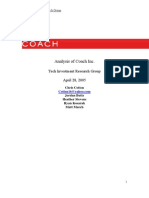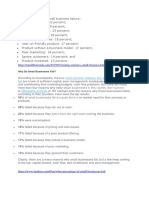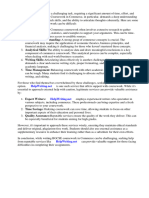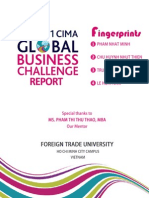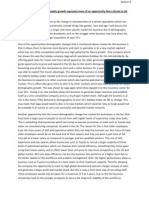Cee Cee's Understanding
Cee Cee's Understanding
Uploaded by
Nicky MontemayorCopyright:
Available Formats
Cee Cee's Understanding
Cee Cee's Understanding
Uploaded by
Nicky MontemayorCopyright
Available Formats
Share this document
Did you find this document useful?
Is this content inappropriate?
Copyright:
Available Formats
Cee Cee's Understanding
Cee Cee's Understanding
Uploaded by
Nicky MontemayorCopyright:
Available Formats
T4 Part B Case Study Exam March and May 2010
CeeCeeing your way to success
Zoe Robinson, Kaplan Publishings content specialist for the T4 Case Study Examination, provides some guidance and advice for those attempting the exam in March and May 2010.
Find any colleague who sat the TOPCIMA exam, the predecessor to the new T4 Part B Case Study examination, and theyll tell you it was unlike any exam they had previously sat. Why? Well there are a few specific reasons that well go into later, but the main overriding factor is the purpose of the exam. As the final instalment of what, for some, may have been a lengthy process of passing your CIMA exams, this is the last chance for the Institute to assess whether youve got what it takes to call yourself a Chartered Management Accountant. As a widely respected and much sought after qualification, there is a strong reputation to protect and so it is unsurprising that CIMA think it important to test your ability to face the realities of the job rather than just rote learn some theories. This is the backdrop for the case study examination. An examination that attempts to simulate the sort of real world situation that you could find yourself in once you are entitled to place the ACMA initials after your name. It will draw upon skills that to date have been less examined, and more importantly it will require a commercial logic and thought process that cant be gained by reading a text book. So, what is the best approach for a student attempting the case study exam? Well, in my mind, there are three golden rules which, if followed will significantly increase your chances of passing: 1. Fully understand the case you are about to sit. Live and breathe it over the coming weeks. Consider all angles and eventualities and place yourself in the position of the Board of Directors. Ask yourself, what keeps you awake at night? 2. Embrace the assessment criteria and ensure you know exactly what the examiners are looking for. This has to be half of the battle and gives you a fighting chance of being able to deliver it. 3. Practise, practise, practise! Some of the skills you will need to demonstrate in the exam hall cannot be gained by sitting in a classroom or reading a book. Time management and communication skills are vital and these can only be developed by replicating the situation you will face on the day. The remainder of this article aims to get you off to a good start in following these rules.
Understanding CeeCee
To fully appreciate the complexities of the CeeCee case study, you have to get to grips with the retail fashion industry. Few industries have undergone such dramatic transformations, with the apparel sector in general looking very different in 2010 from what it did just a few years ago, let alone when CeeCee was formed in 1989. The determinants of fashion In times gone by, fashion took time to spread. Major cities around the world would host biannual fashion weeks more than six months ahead of the approaching season. Following the launch of the new season collections, high-street retailers would spring into action,
1
T4 Part B Case Study Exam March and May 2010
interpreting the styles for their own designs, which were not needed in the shops for several months. Today fashions emerge virtually instantaneously through social networking sites, other internet applications, TV and mobile phones. The rise of the celebrity culture in the late nineties and throughout the noughties has also brought added pressure to keep up with the latest styles. Fashion is no longer driven purely by the seasonal collections from top designers which appear on the catwalks in London, Paris or Milan. Now, the outfit worn by Kylie whilst walking her dog, or what Madonna wears whilst out jogging is just as likely to set off a new trend. These factors have resulted in a must have society which, in a world of instant gratification, has evolved into a more demanding must have now. It is therefore not surprising that the fast fashion sector has experienced such rapid growth. The global players such as Zara and H&M have seen double digit per annum growth in both revenue and number of stores over the past decade. The opening page of the pre-seen states that revenue in the European clothing sector has grown by over 20% during the last decade; equating to annual growth of just over 1.8%. Although on the low side, this is an impressive performance when assessed in the context of the significant price deflation over the same period. This price deflation has been fuelled by the rising market share of the value retailers and the declining cost of production as more of the supply chain is moved to lower wage rate economies. Competitive advantage So to summarise, fashion retailers are being expected to deliver a higher volume of goods, quicker and for lower prices than have been seen in the past. We may think this is good news for CeeCee; after all, this is what they specialise in. To an extent, it is good news. CeeCee are a well established company, with a strong culture and fantastic IT systems that support this competitive advantage the external environment means this is their opportunity to thrive. However, it also brings with it significant threats. The more traditional retailers can no longer afford to ignore the fast fashion trend. Cries of we dont work like that here are being replaced by we have to work like that here. The likes of Marks & Spencer and Next are being forced to adopt some of the fast fashion principles in an attempt to protect their market share. CeeCees original aim of up to the minute fashion styles at affordable prices is no longer unique. Of greater threat is perhaps the rise of the value retailer. As the likes of Primark and George at Asda are speeding up their supply chain, and improving the quality of their products to an acceptable level, it is difficult for many customers to justify paying a premium to have a fashion item now when, if they wait for just a couple of weeks, they can get a similar item for half or even a quarter of the price. So how should CeeCee seek to maintain its competitive advantage? On page four of the pre-seen were provided with a list of five key factors attributed to the success of CeeCees shops. Might these hold the key? Yes and no. All are factors without which CeeCee would not be as successful as it is but it could be argued that, particularly in the current economic climate, they represent threshold competencies and resources rather than being anything unique to CeeCee. So what about the European surveys of consumer clothing wants. Page two of the preseen tells us of four key trends in consumer behaviour that will impact on the development of
2
T4 Part B Case Study Exam March and May 2010
retailers future strategies. It is interesting to note the several references to stock availability and accessibility, which would seem to be in conflict with CeeCees business model of using scarcity to drive frequent customer visits and impulse purchasing. Despite this, there are several aspects that CeeCee should take comfort in. In particular the rise in online shopping, this will sit well with CeeCees recent investment of 10 million into the launch of its new website. Financial performance CeeCee is in a strong financial position. Revenue growth in 2008 of 14.5% exceeds that seen by Zara (9%) and H&M (13%) over similar periods. An overall gross margin of 60.1% also compares favourably with industry averages. ROCE, although slightly down in 2008 on the 2007 level, is still of a level to keep shareholders happy and, perhaps most importantly, the power over suppliers is such that the business has a negative cash operating cycle of 54 days. So, are there any areas of concern? Obviously, the economic climate is putting pressure on all retailers and this has resulted in a forecast increase of only 3% in revenue in 2009, with like-for-like sales being down by 2%. However, this is still very respectable when compared with many high street fashion retailers reporting a fall in like-for-like sales in excess of 10%. So why has CeeCees share price fallen by over 25% since its peak prior to the recession? Yes, its true that at the end of 2009 many European businesses were still some 15% - 20% below their pre-recession peak, but what specifically is reducing the demand for CeeCees shares? The answer can be found by looking at the bigger picture. CeeCees cash balances may be considered too high. At the end of 2008 the company had over 300m of cash. Using the information provided throughout the pre-seen youre able to have a stab at constructing a forecast income statement and statement of financial position as at December 2009 (hint: youll need to take some assumptions on tax payable, receivables and payables but the rest is provided). This reveals that after paying a dividend (based on maintaining the same payout ratio), CeeCee could be sat on as much as 500m at the end of 2009. This is partly the reason why ROCE showed a slight decline in 2008 and we can expect further decline in 2009. Expansion plans have been halved. The reason given is the economic conditions but actually, with money in the bank, this could be an excellent time to accelerate expansion plans, taking advantage of the increased availability of premises in prime locations. Just look at H&M who opened just under 15% more stores in 2009 than they had originally planned. As a result of the issues above, EPS is forecast to increase by just 1.9%. Whilst were told investors were generally pleased with the forecast performance in 2009, its unlikely they were ecstatic.
So, with money in the bank, a negative cash operating cycle and a proven business model, you have to ask, whats stopping CeeCee taking over the fashion world? The future Or to approach it another way, what might come up in the exam? Before I start this section I must stress that I have no prior knowledge, no insiders within CIMA feeding me information, and no way of predicting with any certainty what you could be faced with in the exam. In
3
T4 Part B Case Study Exam March and May 2010
fact, its fair to say, if CIMA were a market it would be strong form efficient; luck and luck alone gets me the abnormal returns! So, with that caveat in place, lets begin. Top of the list would have to be expansion. Were told, on page eight of the pre-seen, that the five-year plan, approved in November 2009, includes expansion outside of Europe. The key question will be whether CeeCee goes it alone, looks towards a franchising model to reduce the risk associated with overseas expansion or looks to acquire an existing retailer in a market. Another option to facilitate expansion would be to establish new fascia. A separate brand to retail specific product lines (ala Zara Home or Accessorize) or to further segment the market (Topshop v Topman for example) are potential options. This strategy has been adopted by most of the real life players and could give CeeCee a chance to further penetrate the markets in which it operates. The on-line business has also been built into the five-year plan and the recent investment means this is a key growth area; something that CeeCee must get right to protect its brand image and give customers what they want. The IT systems are clearly crucial to the delivery of the business model. A problem with these could cause significant issues with stock availability. Were also told of the key role suppliers play in delivering the fast fashion concept. Again, a problem with a supplier, particularly a key supplier, would threaten CeeCees competitive advantage. The absence or departure of key personnel could cause concern for shareholders and disrupt the operations of the business. Specifically, were told of Robertas ambitions to set up her own IT consultancy. This could pose a significant threat if she was to transfer her knowledge of CeeCees systems to a number of their competitors. Finally, we have to recognise that CeeCee could become the subject of a take-over bid. With high cash balances and a depressed share price, it would be a prime target, perhaps for one of the larger competitors were told about in the pre-seen. The list of potential issues could go on and on but I shall stop there in the hope that these give you enough food for thought to be getting on with.
The assessment criteria
As most of your should know by now (if you dont, how have you been studying!) the assessment criteria for the T4 Case Study Examination is very similar to the criteria used in the previous TOPCIMA exam. There are however some crucial differences. The key changes relate to mark allocations which stem from the introduction of a smaller secondary requirement worth 10 marks in total. This means that the main requirement (to prepare a report) will now only be worth 90 marks. Given below is an analysis of each criterion, together with some tips on how to improve your marks. Technical There are five technical marks on offer and these can be gained by using theoretical techniques and frameworks to aid the analysis of the case material. You will broadly be awarded one technical mark for each technical model you include in your script. Calculations (an NPV for example) will also earn technical marks.
4
T4 Part B Case Study Exam March and May 2010
The key to earning technical marks is to ensure you use the model and dont just name drop. Application Application marks are awarded when you use the techniques, frameworks, and calculations to support your analysis of the issues in the unseen material and recommended actions. There are 15 application marks available. It is important to prepare accurate supporting calculations. More marks will be available for more intricate models. So, for example, the application of Mendelows matrix may only be worth one mark, yet an NPV calculation may attract up to six application marks. Diversity You can earn diversity marks for displaying knowledge and understanding of real life situations within the same or similar context. This will often relate to aspects of the retail fashion industry but you shouldnt feel restricted to this. Comments relating to Krafts takeover of Cadbury or Toyotas recent recall of millions of cars, for example, could earn diversity marks if they were relevant to the issue being discussed (shareholder power during a takeover or damage to reputation). Like with technical, you must use your example, not just simply mention it. There are five diversity marks available. You will typically earn one diversity mark each time you display knowledge or understanding of real world situations. Focus There are five focus marks available. To earn them you must select the issues that are regarded by the examiner as the most important and make sure you properly address these issues in your report. Previous guidance issued by the examiner suggests that focus marks should be fairly easy to earn. Perhaps the main reason why students lose marks in this criterion is through poor time management resulting in an incomplete report. I would suggest you look to cover four issues in-depth within your report and make a brief comment on any other issues youre presented with in the unseen information. This is a change from the advice issued for the TOPCIMA exam which was to cover five issues indepth. Prioritisation There are now only five marks available for prioritisation, compared to the previous 10 under the TOPCIMA assessment criteria. To earn prioritisation marks you must rank the issues, stating clearly and concisely your justification for your ranking. Issues should be given high priority because of their impact on CeeCee. Their urgency may also be a factor. You should aim to rank the four key issues that you report will be focusing on. Judgement With 20 marks available, this is a key criterion that you must ensure you devote sufficient time to in your report. To score judgement marks you must exercise commercial and professional judgement to discuss the impact of each prioritised issue on CeeCee, and to identify and evaluate alternative courses of action that CeeCee could take to resolve these issues.
5
T4 Part B Case Study Exam March and May 2010
Very importantly, your analysis should be supported by your work earning marks under the application criterion. Specifically, if information is provided to allow some calculations to be performed, it will be expected that you have done these calculations and that the results of them will form a core part of your analysis of either the issue or an alternative solution. Ethics There are ten marks in total available for ethics. Five are awarded when you highlight and analyse the ethical issues in the case. You must clearly state why you consider the issues to have ethical implications. The other five are given for clear, well justified recommendations for each ethical issue youve discussed. You must provide sound reasoning for your recommended courses of action. I would suggest you aim to cover at least two ethical issues in your report. Logic In total there are 30 logic marks available, 20 of which relate to your report (part 1 of the requirement) and 10 relate to the new smaller secondary requirement. For the 20 marks in your report, you will need to make clear, well justified recommendations for each of the prioritised issues and ensure that the reasoning for the recommended courses of action is clearly stated. The logic criterion is the only criterion where the second requirement scores marks. This gives a clear indication on the scope of this requirement; you should be concentrating on communicating your recommendations in the format requested. The marks will be awarded for both the format of your answer and its content. Integration The final five marks are awarded holistically according to the overall quality and functionality of your report. Your marker will be looking for things such as the flow of your report (are your recommendations consistent with your analysis, which in turn should be consistent with your prioritised issues) and whether you have covered the issues in sufficient depth. Another key aspect is whether you have appreciated how the issues may interlink and have been able to stand back and see the bigger picture rather than just provide advice on four issues in isolation. Practise, practise, practise... The final of my three golden rules is to hone your techniques and develop your skills through sitting practice exams. As mentioned at the start of this article, your ability to gain a pass mark in this exam is about a lot more than the knowledge you have in your head. CIMA are testing a number of key skills required of an accountancy professional including time management, report writing and general communication skills and commercial reasoning. These are not skills you can learn from a text book. If you were leaning how to swim, you wouldnt expect to be able to read a book for a few hours and then get in the pool and instantly be able to do it. Youd perhaps read a book to find out about the principles and look at pictures of how the strokes should be performed. Youd maybe watch a DVD to see a professionals approach or log onto a discussion forum
6
T4 Part B Case Study Exam March and May 2010
dedicated to people trying to learn to swim to find out what common problems people experience and what advice theyd offer. Then youd put on your armbands and go to a small, quiet, shallow pool and practise in a safe environment where there were people around to advise and guide you. Finally, and only when your confidence levels were high, would you take off those armbands and find you were able to swim by yourself. Mock exams are like the learner pool. They are a crucial stage in the journey with the end destination being admittance to the Chartered Institute of Management Accountants. All that is left is for me to wish you good luck. I hope your journey is interesting, fulfilling and, at the end of the day, equips you with skills youll draw upon for the rest of your professional career.
You might also like
- A Complete Lingerie Shop Business Plan: A Key Part Of How To Start A Lingerie StoreFrom EverandA Complete Lingerie Shop Business Plan: A Key Part Of How To Start A Lingerie StoreRating: 2.5 out of 5 stars2.5/5 (3)
- Puma Brand AnalysisDocument23 pagesPuma Brand AnalysisGePRA97% (31)
- Trend ForecastingDocument22 pagesTrend ForecastingAJEET KUMAR100% (1)
- DCF - InvestopediaDocument16 pagesDCF - Investopediamustafa-ahmedNo ratings yet
- Greenlight Capital Q3 2013 LetterDocument8 pagesGreenlight Capital Q3 2013 LetterWall Street WanderlustNo ratings yet
- A Complete Tanning Salon Business Plan: A Key Part Of How To Start A Tanning Bed & Spray On Tan BusinessFrom EverandA Complete Tanning Salon Business Plan: A Key Part Of How To Start A Tanning Bed & Spray On Tan BusinessNo ratings yet
- How To Start A Pool Supply Store: A Complete Pool, Spa, and Hot Tub Equipment and Maintenance Supply Business PlanFrom EverandHow To Start A Pool Supply Store: A Complete Pool, Spa, and Hot Tub Equipment and Maintenance Supply Business PlanNo ratings yet
- Dhl-Amat Dress Code Policy: Policy Owner: Human Resources Revised: 3/25/2016 PurposeDocument3 pagesDhl-Amat Dress Code Policy: Policy Owner: Human Resources Revised: 3/25/2016 Purposejj ggg100% (1)
- B2 2 TestDocument5 pagesB2 2 TestCseh Gyöngyi100% (1)
- CIMA GBC Report - Case CrackersDocument34 pagesCIMA GBC Report - Case CrackersRaja Aulia RezzaNo ratings yet
- CeeceDocument6 pagesCeeceFaisal AhmadNo ratings yet
- Research Article On Growing of The Business Too Fast Resulting OvertradingDocument90 pagesResearch Article On Growing of The Business Too Fast Resulting OvertradingJayantha Chandrakumar KothalawalaNo ratings yet
- GBC 2011 - Case StudyDocument19 pagesGBC 2011 - Case StudyRahul RoonwalNo ratings yet
- Case Study 4 PDFDocument32 pagesCase Study 4 PDFZoha KhaliqNo ratings yet
- GES Investment Report (GUESS)Document8 pagesGES Investment Report (GUESS)mclennan68_13No ratings yet
- Topic 8 How To Tackle EvaluationDocument5 pagesTopic 8 How To Tackle EvaluationMbecha Benedict100% (1)
- 9 David Skok-Website ContentDocument11 pages9 David Skok-Website ContentShiwangi Alind TiwaryNo ratings yet
- CASEDocument18 pagesCASEJay SabioNo ratings yet
- 07 Diversifying Product PortfolioDocument13 pages07 Diversifying Product Portfoliozpqpfgvbk8No ratings yet
- Accounting and Financial ManagementDocument11 pagesAccounting and Financial ManagementAbhishek ModakNo ratings yet
- Case Study (Solved)Document4 pagesCase Study (Solved)Munawar AliNo ratings yet
- Valuation Thesis: Target Corp.: Corporate Finance IIDocument22 pagesValuation Thesis: Target Corp.: Corporate Finance IIagusNo ratings yet
- Exam Focus - The Pre-Seen Case Study For The November 2011 & March 2012 Strategic Level ExamsDocument6 pagesExam Focus - The Pre-Seen Case Study For The November 2011 & March 2012 Strategic Level Examsflavendar178No ratings yet
- Annual Report 2009Document140 pagesAnnual Report 2009Saddam HassanNo ratings yet
- CoachDocument58 pagesCoachNisanart ThadabusapaNo ratings yet
- Stages in Industry Life Cycle, Industry Life Cycle Stages, Industry Life CycleDocument8 pagesStages in Industry Life Cycle, Industry Life Cycle Stages, Industry Life CycleOladipupo Mayowa PaulNo ratings yet
- Fundsmith Equity Fund +18.3 +449.3 +18.2 1.11 1.06 Equities +12.3 +214.8 +11.9 0.56 0.52 UK Bonds +4.6 +47.5 +3.9 N/a N/a Cash +0.3 +6.3 +0.6 N/a N/aDocument13 pagesFundsmith Equity Fund +18.3 +449.3 +18.2 1.11 1.06 Equities +12.3 +214.8 +11.9 0.56 0.52 UK Bonds +4.6 +47.5 +3.9 N/a N/a Cash +0.3 +6.3 +0.6 N/a N/aGiovanno HermawanNo ratings yet
- Video 1: EntrepreneurshipDocument23 pagesVideo 1: EntrepreneurshipelzaracfNo ratings yet
- Bessemer's Ten Laws of EcommerceDocument17 pagesBessemer's Ten Laws of EcommerceBrianFeinsteinNo ratings yet
- Common Sense InvestingDocument20 pagesCommon Sense InvestingAman TiwariNo ratings yet
- Q2 2019Document4 pagesQ2 2019fateh786shNo ratings yet
- Nestlé S.A.: 2005 Full Year Results London & New York Roadshow TranscriptDocument44 pagesNestlé S.A.: 2005 Full Year Results London & New York Roadshow TranscriptAlazar AhmedNo ratings yet
- BSC Oxford Brookes Acca Thesis TopicsDocument7 pagesBSC Oxford Brookes Acca Thesis Topicsafcnoxdhv100% (2)
- 31 31 Interview Questions BankingDocument5 pages31 31 Interview Questions BankingShankari MaharajanNo ratings yet
- Laughing Water Capital - 21Q1Document6 pagesLaughing Water Capital - 21Q1Owen ChenNo ratings yet
- Top 10 Causes of Business FailureDocument24 pagesTop 10 Causes of Business FailureJoão PinhoNo ratings yet
- Transcript PDFDocument106 pagesTranscript PDFVera AlbertNo ratings yet
- Bgcse Coursework CommerceDocument8 pagesBgcse Coursework Commercepkhdyfdjd100% (2)
- Imprtant Final For Next PLC AIC Case StudyDocument6 pagesImprtant Final For Next PLC AIC Case StudyBhavin MehtaNo ratings yet
- LE5 Business Life CycleDocument26 pagesLE5 Business Life Cyclebetty makuveNo ratings yet
- Chapter 12-14 A FixedDocument162 pagesChapter 12-14 A FixedDaniel Luke Higgins0% (2)
- Fef 2023 Semi Annual Letter WebDocument7 pagesFef 2023 Semi Annual Letter WebBen2pop170686No ratings yet
- A Complete Pool Supply Store Business Plan: A Key Part Of How To Start A Pool & Spa Supply BusinessFrom EverandA Complete Pool Supply Store Business Plan: A Key Part Of How To Start A Pool & Spa Supply BusinessNo ratings yet
- (Fingerprints Group) 2011 CIMA Global Business Challenge ReportDocument23 pages(Fingerprints Group) 2011 CIMA Global Business Challenge Reportcrazyfrog1991No ratings yet
- To What Extent Does Demographic Growth Represent More of An Opportunity That A Threat To UK BusinessDocument3 pagesTo What Extent Does Demographic Growth Represent More of An Opportunity That A Threat To UK BusinessYazdan JafriNo ratings yet
- Dropshipping Mastery: Beginner Strategies for Boosting Shopify Sales on a BudgetFrom EverandDropshipping Mastery: Beginner Strategies for Boosting Shopify Sales on a BudgetNo ratings yet
- Elite Tech Business PlanDocument19 pagesElite Tech Business Planapi-311874813No ratings yet
- Business Plan Term PaperDocument8 pagesBusiness Plan Term Paperea3h1c1p100% (1)
- Coach Buyout ValuationDocument11 pagesCoach Buyout ValuationPrashant KhoranaNo ratings yet
- David Barber Halma Strategy SpeechDocument23 pagesDavid Barber Halma Strategy SpeechtheEIONo ratings yet
- Navigating Your Business Through The Covid-19 Crisis: A Multiview EbookDocument10 pagesNavigating Your Business Through The Covid-19 Crisis: A Multiview EbookHeidi BonillaNo ratings yet
- Chapter 1 Overview of Financial StatementDocument11 pagesChapter 1 Overview of Financial StatementTyrone CorpuzNo ratings yet
- How Strong Is ChinaDocument16 pagesHow Strong Is ChinaShashank ShashuNo ratings yet
- Dissertation TescoDocument7 pagesDissertation TescoPaperWritingServiceCheapAnnArbor100% (1)
- Unit 3 CompletateDocument8 pagesUnit 3 CompletateAnca LipanNo ratings yet
- Sample Interview QuestionsDocument4 pagesSample Interview QuestionsDeepakNo ratings yet
- A Complete Sunglasses Shop Business Plan: A Key Part Of How To Start A Sunglasses StoreFrom EverandA Complete Sunglasses Shop Business Plan: A Key Part Of How To Start A Sunglasses StoreRating: 4 out of 5 stars4/5 (1)
- Listen, Innovate, Grow: A Guidebook for Startups and Small Businesses Looking to Acquire and Grow Business CustomersFrom EverandListen, Innovate, Grow: A Guidebook for Startups and Small Businesses Looking to Acquire and Grow Business CustomersNo ratings yet
- The Well-Timed Strategy (Review and Analysis of Navarro's Book)From EverandThe Well-Timed Strategy (Review and Analysis of Navarro's Book)No ratings yet
- Wrap Top A0Document2 pagesWrap Top A0Diana BogdanNo ratings yet
- Documento Describir Gustos. AA2-EV02.Document4 pagesDocumento Describir Gustos. AA2-EV02.hilary rubioNo ratings yet
- RP 0104 - Utility Uniform and Individual Combat EquipmentDocument7 pagesRP 0104 - Utility Uniform and Individual Combat EquipmentDiego Alejandro Tellez ChavezNo ratings yet
- Electrical Resistant Heavy Duty Safety ShoesDocument5 pagesElectrical Resistant Heavy Duty Safety ShoesEunice GayetaNo ratings yet
- Patterns by Amy LowellDocument2 pagesPatterns by Amy LowellMae MallapreNo ratings yet
- Catrina ChecklistDocument2 pagesCatrina ChecklistScribdTranslationsNo ratings yet
- Physical Education: Social Dances and Dance MixersDocument9 pagesPhysical Education: Social Dances and Dance MixersRow KneelNo ratings yet
- Nef Upper Filetest 2aDocument8 pagesNef Upper Filetest 2aalberthx100% (1)
- Tle Dressmaking9 q2 m6Document6 pagesTle Dressmaking9 q2 m6ALLYSSA MAE PELONIANo ratings yet
- Research ProposalDocument9 pagesResearch ProposalNitya GuptaNo ratings yet
- Adjectives: Comparative and SuperlativeDocument3 pagesAdjectives: Comparative and SuperlativeBias BargowiNo ratings yet
- Uniforms and Uniform RoomDocument7 pagesUniforms and Uniform RoomSukriti MishraNo ratings yet
- Monroe Turtleneck Sewing InstructionsDocument6 pagesMonroe Turtleneck Sewing InstructionsGinetta GuitteaudNo ratings yet
- BurdaTopBloggerPDF v3Document7 pagesBurdaTopBloggerPDF v3Alina Iuliana Radulescu100% (4)
- Expository EssayDocument9 pagesExpository Essayeka fajariyantoNo ratings yet
- Dior Lip Balm - Google SearchDocument1 pageDior Lip Balm - Google SearchJanaNo ratings yet
- Grammar Focus Unit 9 - Part OneDocument20 pagesGrammar Focus Unit 9 - Part OneFelipe RibeiroNo ratings yet
- Leseprobe 9783791345796Document23 pagesLeseprobe 9783791345796GodwinNo ratings yet
- Describing People Esl Speaking Cards WorksheetDocument1 pageDescribing People Esl Speaking Cards WorksheetKenfritz Kant Vixent100% (1)
- SCM BataDocument22 pagesSCM BataMuhammad Qasim MalikNo ratings yet
- Tilda S Studio by Tone FinnangerDocument8 pagesTilda S Studio by Tone FinnangerSara Constantino80% (5)
- Spring Fashion - Wardrobe EssentialsDocument2 pagesSpring Fashion - Wardrobe EssentialsClassic Polo eComNo ratings yet
- A. Introduction To Leather Goods Designing - EBDPD - LGT IIIDocument57 pagesA. Introduction To Leather Goods Designing - EBDPD - LGT IIIIndranil SahaNo ratings yet
- Ruby Doll Eng PatternDocument12 pagesRuby Doll Eng Patternsz.cilla100% (4)
- Nicera Uniform Layout 2022Document3 pagesNicera Uniform Layout 2022Patrick Dave RevillaNo ratings yet
- Short Essay On FashionDocument2 pagesShort Essay On Fashioninkedideaas129100% (2)

